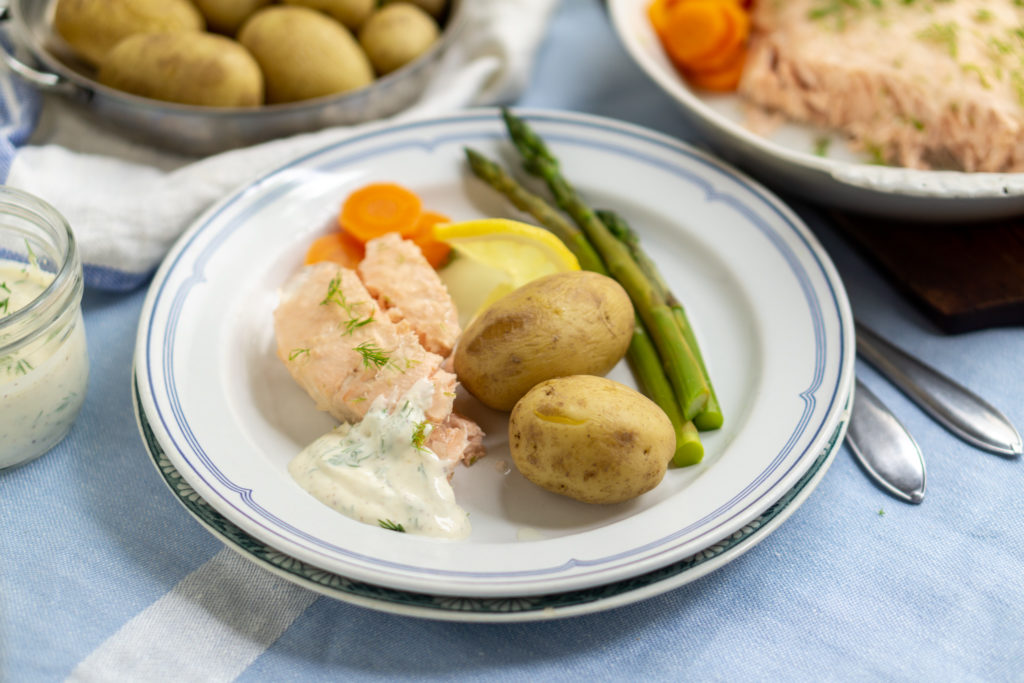There are only three ways of eating salmon that are “dignified for humankind”: gravlax, smoked salmon, and cold poached salmon in brine. At least that’s what Svenska Dagbladet‘s Ane den Gamle suggested in November in 1925, tongue-in-cheek.
Apparently, Ane had become tired of the Stockholmers’ way of in “99 cases out of 100” serving salmon or pike perch at a dinner party, warmed and with mayonnaise to remove the flavor. To comabt this lack of variety, Ane suggested whitefish.
Well, I wouldn’t go as far as Ane, but cold poached salmon is pretty unbeatable on a warm summer’s day. Whether you serve it for Midsummer or just for festive lunch or dinner, the dish is a convenient choice as you can prepare it the day before. Here’s how to do it, in stop motion:
Why cold poaching the salmon?
While I have yet to gather more sources on the topic, it seems like Swedes cooked salmon this way because of the preservative qualities of the vinegar. For example, recipe number 91 in Maria Elzberg’s cookbook from 1751 recommends that you add extra vinegar to the pot where you store the salmon, and you can then “eat of him [the salmon] whenever it pleases you”.
Elzberg flavors the brine a bit differently than the recipes of today: she adds peppercorns and bay leaves, too, but also adds ginger and mace. There are a few much simpler recipes, such as recipe number 256 in Hemmets kokbok (1917). The recipe for “fish boiled in pieces” only consists of fish, water, spirit vinegar, and salt.

But not all recipes add the spirit vinegar, which gives the salmon a slightly acidic taste. For example, Gustafwa Björklund’s 1847 cookbook leaves it out in its recipe number 129 that shares how to make poached salmon seasoned the same way as the recipe I share below. ICA-förlaget’s Den godaste maten from 1949 has a recipe for “salmon, warm or cold” which includes spirit vinegar, but also note that “the spirit vinegar in the brine can be left out”.
The tradition to add a gelatine glaze to the salmon is also old — Cajsa Warg has in her 1755 cookbook a recipe for lax i gelée. Nowadays, we have the convenience of gelatine sheets or powder. Cajsa Warg instead instructs you to let the salmon boil in water with deer antlers to thicken it. I may skip trying that particular recipe…

How to make cold poached salmon
The cold poached salmon is simple to prepare in advance. Enjoy it with the season’s new potatoes as well as some mayonnaise or skarpsås, a mustard-flavored sauce. Don’t have any spirit vinegar? Leave it out altogether, or add a bit of white vinegar instead.
1 medium yellow onion
1 medium carrot
3/4 dl (1/3 cup) spirit vinegar (12%) — ättikssprit
1,5 liter (6 cups) water
10 whole white peppercorns
5 whole allspice
2 bay leaves
1/2 bunch of dill
800 gr (1 4/5 pounds) fresh salmon
2 tsp salt
Optional: 2 sheets of gelatine + cold water
For serving: freshly boiled potatoes, 1/2 bunch of dill, mayonnaise
- To prepare the brine, you’ll ideally need a large pot. Peel and chop the onion and carrot. Then them in the pot, together with the spirit vinegar, water, spices and herbs. Bring the brine to a boil and then let it simmer for five minutes.
- While the brine is simmering, prepare the salmon by cutting it into portion slices. Add the salmon to the brine and let it boil for one minute.
- Remove the pot from the stove and cover it. Let the salmon and the brine cool. Once it’s cold enough, store it in the fridge. Enjoy it once it is cold — it is a great dish to prepare the day before.
- If you want to add a gelatine glaze: Once you’ve removed the salmon from the stove, add cold water to a small bowl and add the gelatine sheets. Let the sheets soften in the water for a few minutes, then squeeze off the excess liquid from the sheets. Pour away the water, then add the warm brine to the bowl. Add the gelatine sheets and stir until they have melted completely. Stir the gelatine brine into the rest of the brine and let all of it cool, as in the previous step.
Suggestions
If you’d rather poach the entire salmon, you need to make sure you have a pot that is large enough to fit it in. Alternatively, you can prepare the brine in the oven: preheat the oven to 200°C (390°F), place the salmon in a large, deep oven-proof dish together with all other ingredients but the water. Bring the water to boil in a kettle, then pour it over the salmon dish. Cook it in the oven for 5-10 minutes, then let it cool as above.



Hello
Could you tell me the amount of salt for the brine !
Hi, thank you for commenting — I’ve clarified in the recipe. I tend to use about two teaspoons of salt.
Just made this dish this week and LOVED it! So simple, fresh, and delicious! It is nice to have recipes like this one that let the actual flavor of the food to shine as opposed to dousing a dish with spices.
Kerry, I’m so happy to hear that! This salmon has turned into a summer favorite for me.
What you say about the taste is one of the things I like best when it comes to Scandinavian cuisine — it’s all about highlighting the food’s natural flavor, even if it’s subtle.
Btw, checked out your blog and now the reversed manhattan is next on the cocktail list to try… big maraschino fan!